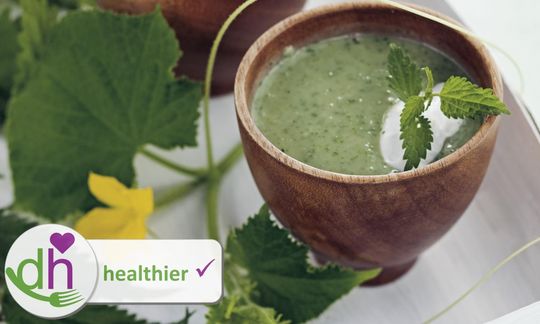Healthy Nettle and Potato Soup with Vegan Stock and Carrots
vegan
Ingredients (for servings, )
| For the soup | |
|---|---|
| ⅔ oz | Nettles, large, raw (hemp nettles, organic?) |
| 20 ml | Rapeseed oil (canola, HOLL oil, kernel oil), cold pressed?, organic? (0.65 oz) |
| 1 | Onions, raw (organic?) (3.9 oz) |
| 1 | Carrots (carrots), raw (organic?) (2.1 oz) |
| 2 | Potatoes, raw (organic?) (6.3 oz) |
| 1 ½ liter | Vegan vegetable stock, organic? (53 oz) |
| Seasoning | |
| 1 dash | Table salt (table salt, raw?, organic?) (0.01 oz) |
| 1 dash | Black pepper (organic?, raw?) (0.00 oz) |
| 75 ml | Oat cream, oat cuisine, oat cream (raw?, organic?) (2.7 oz) |
Equipment
- hand-held blender / immersion blender or blender
- stove
- saucepan
Type of preparation
- cook
- chop or grind
- blend
- sweat
- season to taste
Preparation
For the soup
Rinse the nettles with water and then pat dry.Heat the canola oil in a saucepan on medium heat. Peel the onion and cut the onion and carrots into small cubes. Sweat both in the saucepan until the onions are translucent.
Our motivation (apple symbol) for creating this healthier version and a link to the original recipe can be found directly above the recipe photo.
In the meantime, peel and cube the potatoes and then add to the saucepan. After 1 minute, pour the vegan stock in and let everything simmer for 30 minutes.
Coarsely chop the nettles and add to the saucepan 10 minutes before the end of the cooking time.
Seasoning
Finely purée the soup with an immersion mixer and season to taste with salt and pepper.Add the oat cream to the soup and serve hot.
The original recipe calls for soy cream instead of oat cream.
|
Nutritional Information per person
Convert per 100g
|
2000 kcal | |
|---|---|---|
| Energy | 172 kcal | 8.6% |
| Fat/Lipids | 8.3 g | 11.9% |
| Saturated Fats | 0.68 g | 3.4% |
| Carbohydrates (inc.dietary fiber) | 23 g | 8.6% |
| Sugars | 6.6 g | 7.4% |
| Fiber | 4.7 g | 18.9% |
| Protein/Albumin | 2.9 g | 5.9% |
| Cooking Salt (Na:136.3 mg) | 346 mg | 14.4% |
| Essential micronutrients with the highest proportions | per person | 2000 kcal | |
|---|---|---|---|
| Vit | Vitamin K | 86 µg | 115.0% |
| Vit | Vitamin A, as RAE | 379 µg | 47.0% |
| Vit | Vitamin C (ascorbic acid) | 25 mg | 32.0% |
| Elem | Potassium, K | 615 mg | 31.0% |
| Fat | Alpha-Linolenic acid; ALA; 18:3 omega-3 | 0.62 g | 31.0% |
| Vit | Vitamin B9, B11 (Folate, as the active form of folic acid) | 53 µg | 27.0% |
| Vit | Vitamin B6 (pyridoxine) | 0.36 mg | 26.0% |
| Min | Manganese, Mn | 0.49 mg | 24.0% |
| Min | Copper, Cu | 0.18 mg | 18.0% |
| Sodium, Na | 136 mg | 17.0% | |
Detailed Nutritional Information per Person for this Recipe
The majority of the nutritional information comes from the USDA (US Department of Agriculture). This means that the information for natural products is often incomplete or only given within broader categories, whereas in most cases products made from these have more complete information displayed.
If we take flaxseed, for example, the important essential amino acid ALA (omega-3) is only included in an overarching category whereas for flaxseed oil ALA is listed specifically. In time, we will be able to change this, but it will require a lot of work. An “i” appears behind ingredients that have been adjusted and an explanation appears when you hover over this symbol.
For Erb Muesli, the original calculations resulted in 48 % of the daily requirement of ALA — but with the correction, we see that the muesli actually covers >100 % of the necessary recommendation for the omega-3 fatty acid ALA. Our goal is to eventually be able to compare the nutritional value of our recipes with those that are used in conventional western lifestyles.
| Essential fatty acids | per person | 2000 kcal |
|---|---|---|
| Alpha-Linolenic acid; ALA; 18:3 omega-3 | 0.62 g | 31.0% |
| Linoleic acid; LA; 18:2 omega-6 | 1.5 g | 15.0% |
| Essential amino acids | per person | 2000 kcal |
|---|---|---|
| Threonine (Thr, T, irreversibly transaminated) | 0.13 g | 14.0% |
| Tryptophan (Trp, W) | 0.03 g | 11.0% |
| Isoleucine (Ile, I) | 0.09 g | 7.0% |
| Lysine (Lys, K, irreversibly transaminated) | 0.13 g | 7.0% |
| Valin (Val, V) | 0.11 g | 7.0% |
| Leucine (Leu, L) | 0.14 g | 6.0% |
| Phenylalanine (Phe, F) | 0.10 g | 6.0% |
| Methionine (Met, M) | 0.03 g | 3.0% |
| Vitamins | per person | 2000 kcal |
|---|---|---|
| Vitamin K | 86 µg | 115.0% |
| Vitamin A, as RAE | 379 µg | 47.0% |
| Vitamin C (ascorbic acid) | 25 mg | 32.0% |
| Vitamin B9, B11 (Folate, as the active form of folic acid) | 53 µg | 27.0% |
| Vitamin B6 (pyridoxine) | 0.36 mg | 26.0% |
| Vitamin E, as a-TEs | 1.9 mg | 16.0% |
| Vitamin B1 (Thiamine) | 0.13 mg | 12.0% |
| Vitamin B3 (Niacin) | 1.4 mg | 9.0% |
| Vitamin B5 (Pantothenic acid) | 0.49 mg | 8.0% |
| Vitamin B7 (Biotin, ex vitamin H) | 3.9 µg | 8.0% |
| Vitamin B2 (Riboflavin) | 0.09 mg | 7.0% |
| Essential macroelements (macronutrients) | per person | 2000 kcal |
|---|---|---|
| Potassium, K | 615 mg | 31.0% |
| Sodium, Na | 136 mg | 17.0% |
| Phosphorus, P | 104 mg | 15.0% |
| Calcium, Ca | 103 mg | 13.0% |
| Magnesium, Mg | 43 mg | 12.0% |
| Essential trace elements (micronutrients) | per person | 2000 kcal |
|---|---|---|
| Manganese, Mn | 0.49 mg | 24.0% |
| Copper, Cu | 0.18 mg | 18.0% |
| Iron, Fe | 1.7 mg | 12.0% |
| Zinc, Zn | 0.60 mg | 6.0% |
| Fluorine, F | 189 µg | 5.0% |
| Iod, I (Jod, J) | 4.0 µg | 3.0% |
| Selenium, Se | 0.96 µg | 2.0% |
Südwest-Verlag München / Bassermann / Irisiana Verlagsgruppe Random House GmbH, Björn Moschinski
Raw recipes 3 (1), Cooked recipes 57 (6)
Additional photos (12)
The cookbook "here & now vegan" by Björn Moschinski shows us seasonal cuisine with market-fresh local ingredients, some of which can be found directly in nature.
Since this book is written in German, a description is omitted here. If you are interested, please switch to German in the menu.
This healthy nettle and potato soup with carrots calls for vegan stock. You can either make homemade stock in advance or purchase a store-bought variety.
New nutritional profile: According to GDA guidelines, one serving of this recipe meets the recommended daily requirement of vitamin K, almost 50 % of the recommended daily requirement of vitamin A, and about 30 % of the recommended daily requirement of vitamin C and potassium. The soup also has a good ratio of omega-6 to omega-3 fatty acids, which in this case (2:1) clearly complies with the recommended 5:1 ratio.
Nettles as an ingredient: In this recipe, the author uses nettles as an ingredient. Nettles are a plant that many people usually just think of as being an invasive weed. However, others know that it contains many valuable substances and use it as a medicinal plant. But this ambivalence toward nettles doesn’t change the fact that they are a culinary enrichment for everyone’s diet. The recipe presented here is just one of many delicious examples of dishes that you can use nettles in.
Potato varieties: Since all of the ingredients are puréed before serving, you should decide whether you prefer to use all-purpose or starchy potatoes. The original recipe calls for waxy potatoes.
Picking nettles: If you are picking the nettles yourself, we recommend that you pick primarily young leaves as they taste the best. Protect your hands when picking nettles by using a thick hand towel or wearing gloves.
Adjusting the flavor and consistency: If you want to intensify the typical nettle flavor, you can increase the amount of nettles. And if you want to make the soup thicker, you can reduce the amount of vegetable broth.
Vegetable stock: Vegetable stock is sold in most well-stocked supermarkets, usually in jars or Tetra Pak cartons. However, it is relatively uncomplicated to make your own stock. And with homemade stock, you can adjust the ingredients based on your taste preferences. In addition, we recommend that you make your own since many commercial stocks contain artificial additives and preservatives and are of lower nutritional value. Here is a link to our own recipe: Vegan Stock.
Omitting processed products and reducing the oil: For this healthier version, we use oat cream instead of soy cream. You can either buy oat cream at an organic supermarket (not widely available in the US) or simply make it yourself. To do so, please follow this link. The advantage is that with this one change you can make the recipe without both soy and processed products. In place of the vegan margarine called for in the original recipe, you can use canola oil. We have also reduced the amount from 50 ml to 20 ml. Read more about this here:
A Vegan Diet Can Be Unhealthy. Nutrition Mistakes.




